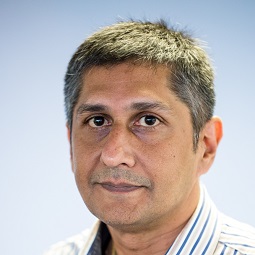Modelling a changed world: Providing expert insight for modelling of COVID-19
The CSIR’s Prof. Pravesh Debba is leading a group of digital modellers and collaborators that aim to share critical information, knowledge and data with the national Department of Health, the National Institute for Communicable Diseases (NICD) and other government departments, in responding effectively to the challenges brought about by the COVID-19 pandemic.
The CSIR’s Prof. Pravesh Debba is leading a group of digital modellers and collaborators that aim to share critical information, knowledge and data with the national Department of Health, the National Institute for Communicable Diseases (NICD) and other government departments, in responding effectively to the challenges brought about by the COVID-19 pandemic.
In helping to shape an effective response to curtail the rate of the spread of COVID-19, a modelling team has been assembled at the request of the NICD. The team uses an evidence-based scientific process to assist decision and policy makers to allocate resources more effectively, conduct scenario analysis and help inform the different levels of lockdown. Data science, as well as statistical and mathematical modelling, are at the forefront of understanding the spread of the outbreak and being able to forecast the number of deaths, test different strategies and interventions, determine the number of those who are critically ill at a specific point in time at a particular location, as well as determine if there are adequate intensive care unit beds, ventilators and other critical resources within our healthcare system.
“One of the greatest challenges in adequately responding to such disasters lies in the weakness of our systems when it comes to collecting quality, timely and disaggregated spatial data. The lack of interoperability, standards and sharing of data between different levels – local, regional, national, and internationally – limits the extent to which we can effectively respond to the COVID-19 situation. The ownership of this information and data ranges across various government, academic, public and private sectors, as well as science councils,” says Debba, who holds a PhD in Spatial Statistics from the International Institute for Geo-Information Science and Earth Observation and Wageningen University in the Netherlands and an MSc in Biostatistics from the University of Hasselt in Belgium.
“The COVID-19 pandemic is testing our natural behaviour somewhat beyond our imagination, forcing us to work and operate differently. Modelling of COVID-19 has the ability to understand the effect of the different levels of lockdown, both socially (social distancing) and economically. This helps government make decisions based on science,” he says.
Through collaboration with the South African Medical Research Council, the Human Science Research Council, and the universities of KwaZulu-Natal, Pretoria, Witwatersrand and Hasselt in Belgium, as well as the NICD, the modelling group focuses on three different modelling approaches.
The first is a data-driven modelling approach, performed to determine reliable forecasting of the number of cases, recoveries and deaths at national and provincial levels. This non-linear epidemiological growth model is crucial to being able to effectively manage the rising case load and allocate resources over the short term, as well as develop continuous updates of the final size of the outbreak, turning point and duration. The model is also compared to the compartmentalised Susceptible-Exposed-Infected-Recovered (SEIR) epidemiological models used by the National Coronavirus Command Council through the NICD.
The second approach is to use ward-level case data to support and improve the understanding of area-level variation of the COVID-19 epidemic in South Africa and its drivers for targeted interventions. The objective was to assess the spatial epidemic dynamics of COVID-19 in South Africa to determine local clusters of infection and hotspot detection. By complementing this derived spatial database with socioeconomic data and environmental data (and hopefully in future also adding burden of diseases), spatial statistical methods were used to perform spatial regression and interpolation. This approach also helped to assess spatial dependence at both global and local levels to identify locations of high COVID-19 rates and predict where additional clusters of infection will occur.
The third modelling approach was to assist the NICD in developing a spatial SEIR model that would be able to respond to different lockdown scenarios in different municipalities, based on the forecast of the pandemic at a local level, while taking into account differences in transmission rates, population density, demographics and other factors at a localised level.
In addition, the modelling community across the country is willing to help in various ways to address some of the most challenging questions that the world is currently faced with. The uncertainty in the models is adding to the complexity of the problem. Prof Debba has been playing a leading role in bringing together modellers from across the country to publicly discuss, compare and scrutinise their work. This is done in the form of presentations on a weekly basis. Some of these presentations are then elevated to other forums and the work is discussed and taken up as contributing to certain national decisions for the country. The presentations and recordings can be viewed at https://sites.google.com/view/covid19modelling/home.
For Prof. Debba, the COVID-19 pandemic has reinforced the value of collaborating, sharing data and information, performing quality data checks, and exercising good analytical modelling and data science to contribute to the scientific fraternity, enhancing decision making for the country. This approach can illuminate the difficult, but critical, choices that are constantly being made.


